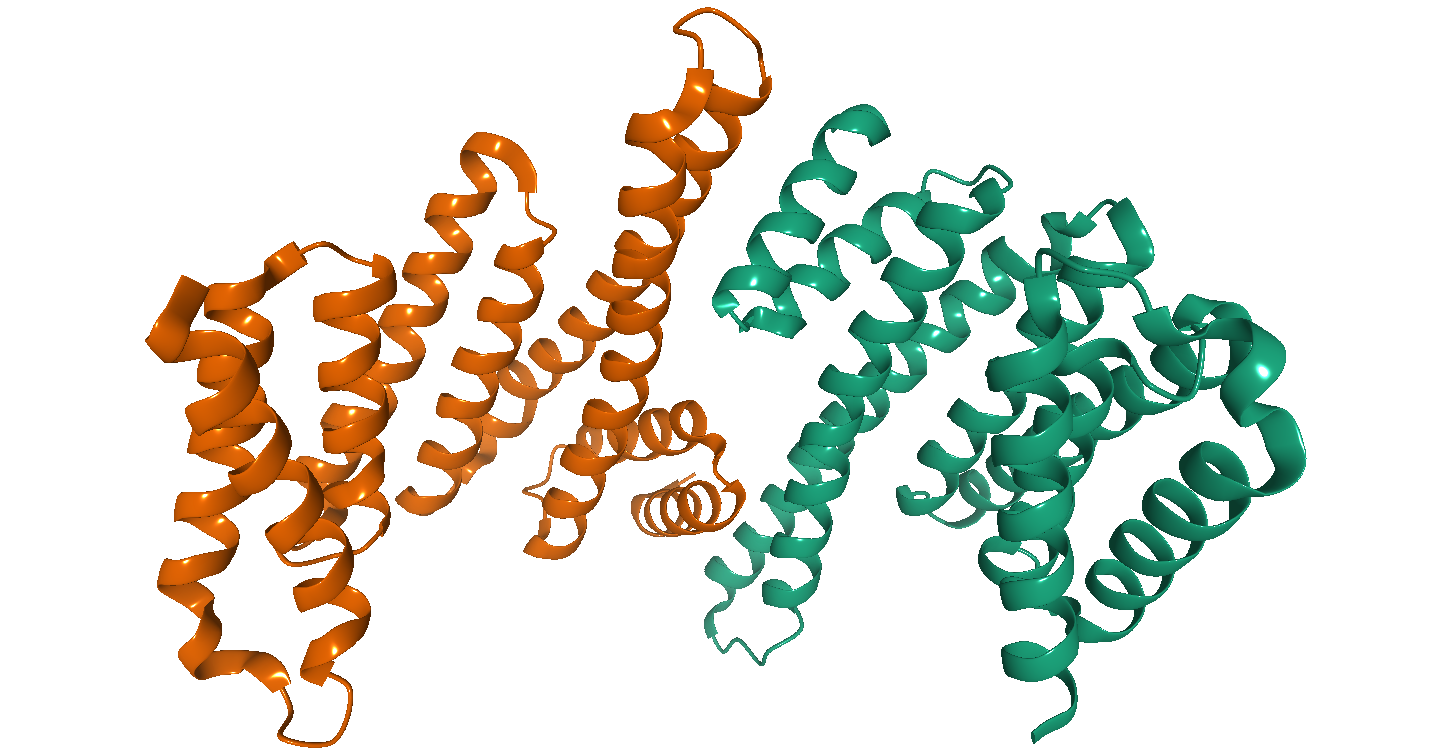14-3-3 protein
14-3-3 proteins are a family of conserved regulatory molecules expressed in all eukaryotic cells. They were first identified in brain tissue in 1967 by Moore and Perez during studies of brain phosphoproteins. The name "14-3-3" refers to the proteins' migration pattern on DEAE-cellulose chromatography, where they were found in the 14th fraction and had a 3.3 S sedimentation coefficient. These proteins have since been recognized for their role in a wide range of vital cellular processes, including signal transduction, cell cycle control, apoptosis, and cellular stress responses.
Structure and Isoforms[edit | edit source]
14-3-3 proteins are approximately 30 kDa in size and form either homo- or hetero-dimers. Each 14-3-3 monomer has a conserved amphipathic groove that interacts with phosphorylated serine/threonine-containing motifs in target proteins. In humans, there are seven isoforms of 14-3-3 proteins, named beta (β), gamma (γ), epsilon (ε), sigma (σ), zeta (ζ), tau (τ), and eta (η), encoded by different genes. These isoforms exhibit high sequence homology but can have distinct expression patterns and functions.
Function[edit | edit source]
14-3-3 proteins play a crucial role in a broad array of cellular mechanisms. By binding to phosphorylated motifs on target proteins, they can alter the target's activity, localization, and stability. This interaction is essential for the regulation of various signaling pathways involved in cell proliferation, survival, and apoptosis. For example, 14-3-3 proteins can sequester cyclin-dependent kinase inhibitors (CDKIs) in the cytoplasm, thereby promoting cell cycle progression. They are also involved in the regulation of apoptosis through interactions with proteins such as BAD and BAX.
Clinical Significance[edit | edit source]
Given their role in critical cellular processes, alterations in 14-3-3 protein expression or function have been implicated in the pathogenesis of several diseases, including cancer, neurodegenerative diseases like Alzheimer's disease, and metabolic disorders. In particular, the sigma isoform is a tumor suppressor that is often downregulated in various cancers. Additionally, 14-3-3 proteins have been studied as potential biomarkers for disease diagnosis and prognosis, as well as targets for therapeutic intervention.
Research Tools[edit | edit source]
14-3-3 proteins are also valuable research tools. For instance, they are used in yeast two-hybrid screening for identifying protein-protein interactions. Moreover, the development of 14-3-3 protein inhibitors is an area of active research, aiming to modulate 14-3-3-mediated signaling pathways for therapeutic purposes.
This article is a biochemistry stub. You can help WikiMD by expanding it!
Transform your life with W8MD's budget GLP1 injections from $125
W8MD offers a medical weight loss program NYC and a clinic to lose weight in Philadelphia. Our W8MD's physician supervised medical weight loss centers in NYC provides expert medical guidance, and offers telemedicine options for convenience.
Why choose W8MD?
- Comprehensive care with FDA-approved weight loss medications including:
- loss injections in NYC both generic and brand names:
- weight loss medications including Phentermine, Qsymia, Diethylpropion etc.
- Accept most insurances for visits or discounted self pay cost.
- Generic weight loss injections starting from just $125.00 for the starting dose
- In person weight loss NYC and telemedicine medical weight loss options in New York city available
- Budget GLP1 weight loss injections in NYC starting from $125.00 biweekly with insurance!
Book Your Appointment
Start your NYC weight loss journey today at our NYC medical weight loss, and Philadelphia medical weight loss Call (718)946-5500 for NY and 215 676 2334 for PA
Search WikiMD
Ad.Tired of being Overweight? Try W8MD's NYC physician weight loss.
Semaglutide (Ozempic / Wegovy and Tirzepatide (Mounjaro / Zepbound) available. Call 718 946 5500.
Advertise on WikiMD
|
WikiMD's Wellness Encyclopedia |
| Let Food Be Thy Medicine Medicine Thy Food - Hippocrates |
Translate this page: - East Asian
中文,
日本,
한국어,
South Asian
हिन्दी,
தமிழ்,
తెలుగు,
Urdu,
ಕನ್ನಡ,
Southeast Asian
Indonesian,
Vietnamese,
Thai,
မြန်မာဘာသာ,
বাংলা
European
español,
Deutsch,
français,
Greek,
português do Brasil,
polski,
română,
русский,
Nederlands,
norsk,
svenska,
suomi,
Italian
Middle Eastern & African
عربى,
Turkish,
Persian,
Hebrew,
Afrikaans,
isiZulu,
Kiswahili,
Other
Bulgarian,
Hungarian,
Czech,
Swedish,
മലയാളം,
मराठी,
ਪੰਜਾਬੀ,
ગુજરાતી,
Portuguese,
Ukrainian
Medical Disclaimer: WikiMD is not a substitute for professional medical advice. The information on WikiMD is provided as an information resource only, may be incorrect, outdated or misleading, and is not to be used or relied on for any diagnostic or treatment purposes. Please consult your health care provider before making any healthcare decisions or for guidance about a specific medical condition. WikiMD expressly disclaims responsibility, and shall have no liability, for any damages, loss, injury, or liability whatsoever suffered as a result of your reliance on the information contained in this site. By visiting this site you agree to the foregoing terms and conditions, which may from time to time be changed or supplemented by WikiMD. If you do not agree to the foregoing terms and conditions, you should not enter or use this site. See full disclaimer.
Credits:Most images are courtesy of Wikimedia commons, and templates, categories Wikipedia, licensed under CC BY SA or similar.
Contributors: Prab R. Tumpati, MD




